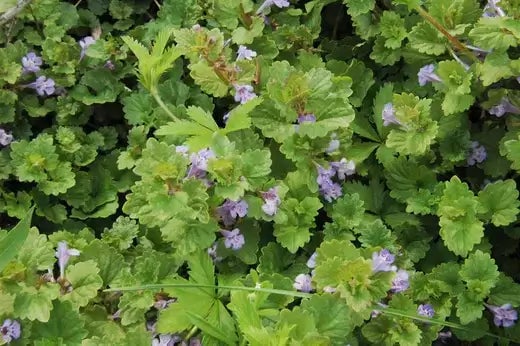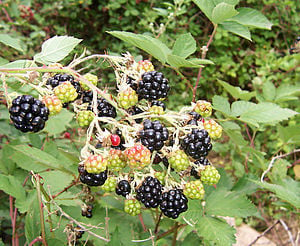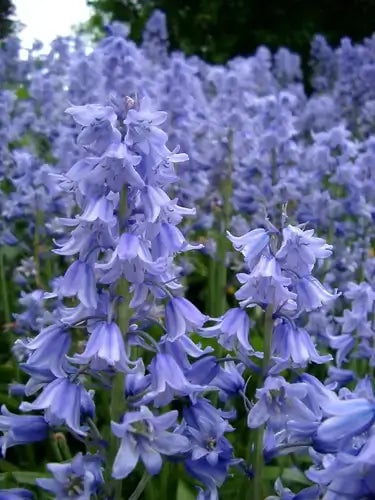Exploring the Enchanting Allure of Bluebells

In botanical wonders, the bluebell is a testament to nature's creations' beauty and resilience. Known for its delicate yet vibrant appearance and its ability to transform woodlands into ethereal landscapes, the bluebell (Hyacinthoides non-scripta) is a unique perennial that has captured the hearts of botanists, nature enthusiasts, and artists alike. With its enchanting presence and remarkable adaptations, the bluebell holds a special place in the world of plants.
Aesthetic Majesty
One must first delve into its aesthetic majesty before discussing the bluebell. The bluebell's most distinctive feature is its bell-shaped flowers hanging delicately from slender stems. As the name suggests, these flowers come in a captivating shade of blue, ranging from the palest azure to a deep, rich cobalt. A subtle sheen often enhances the coloration, giving the petals a slightly glossy appearance that adds to their allure.
The arrangement of bluebells in woodlands is particularly enchanting. During the spring months, vast carpets of bluebells blanket the forest floors, creating a breathtaking spectacle that is both serene and mesmerizing. The sunlight filtering across the trees, casting a soft glow upon the sea of blue, evokes a sense of wonder that is difficult to put into words.
Ecological Significance
Beyond its captivating beauty, the bluebell is crucial to its ecosystem. As a perennial, it has adapted to thrive in specific environments, often forming dense colonies in woodlands and shaded areas. The timing of its bloom, usually from April to May, coincides with the period before the trees fully leaf out. This adaptation allows the bluebell to harness sunlight before the canopy becomes too dense, ensuring its survival in low-light conditions.
Furthermore, the bluebell's nectar-rich flowers are a vital food source for early-emerging pollinators such as bees and butterflies. These insects play a crucial role in pollinating various plant species, contributing to the overall health and biodiversity of the ecosystem. In this way, the bluebell exemplifies the intricate web of relationships that sustain life in the natural world.
Historical and Cultural Significance
The bluebell's allure extends beyond its ecological role, permeating human culture and history. In many cultures, bluebells symbolize gratitude, humility, and everlasting love. In folklore, they are often linked to fairy realms and magical enchantments, enhancing their mystique and captivating the human imagination.
Bluebells have been used for their medicinal properties in some parts of the world. Historically, bluebell extracts were believed to possess properties that could aid in treating specific ailments, such as coughs and digestive issues. However, it's important to note that the plant can be toxic if ingested in large quantities, emphasizing the delicate balance between its potential benefits and risks.
Conservation Challenges
Despite its enchanting presence, the bluebell faces specific conservation challenges. Habitat loss due to urbanization, deforestation, and changes in land use can disrupt the delicate ecosystems where bluebells thrive. Invasive species can also pose a threat by outcompeting native plants and altering the dynamics of the woodland environment.
Efforts to conserve bluebell populations include protecting and restoring their natural habitats and raising awareness about their importance. Some areas have designated bluebell woods as protected sites, allowing these unique perennials to continue enchanting future generations.
Cultivation and Care
Cultivation and care are essential considerations for those who wish to introduce the magic of bluebells into their own gardens. Bluebells can be grown from bulbs and are often planted in the fall for spring bloom. They prefer shaded or partially shaded areas with well-draining soil. When planting, it's essential to handle the bulbs carefully, as they are fragile and susceptible to damage.
Once established, bluebells are relatively low-maintenance, requiring minimal attention beyond occasional watering and mulching to retain soil moisture. It's important to avoid disturbing established colonies, as bluebells can spread and naturalize over time, creating breathtaking displays reminiscent of their wild counterparts.
With its enchanting beauty, ecological significance, and cultural symbolism, the bluebell stands as a unique perennial that captivates all who encounter it. From its delicate blue flowers that transform woodlands into fairy tale landscapes to its vital role in supporting pollinators and its historical ties to human culture, the bluebell holds a special place in the intricate tapestry of life on Earth.
As we continue to appreciate and understand the importance of preserving biodiversity, the bluebell reminds us of the delicate balance in our ecosystems. By nurturing these captivating perennials and their habitats, we contribute to protecting both natural beauty and the intricate relationships that sustain life on our planet.
Unexpected Uses for Bluebells
The springtime flower Hyacinthoides non-scripta is an iconic woodland feature throughout European forests and select regions of North America. Their purple-blue color and soft nodding flowers create visions of serene woodland floors and magical fairy realms. Bluebells are widely recognized as indicators of approaching warm weather, and in folklore, they are thought to produce sounds when fairies approach. While bluebells are renowned for their natural beauty many people overlook their diverse historical and cultural applications which can be quite astonishing. These enchanting flowers have been appreciated through unexpected uses and beliefs throughout history.
Historically, bluebells served as an archaic type of glue. The adhesive quality of bluebell sap from bulbs and leaves was a page-binding material in bookmaking throughout medieval Europe, particularly in Britain. When resources were scarce, bookmakers identified that the sap could function as glue to attach pages to a book's spine. The quick-drying adhesive maintained sufficient durability, which proved particularly beneficial. Early glue created from this sap did not reach the strength of modern adhesive materials. Still, it functioned exceptionally well during its era and played an essential role in monastic scriptoria and early bookmaking workshops.
Bluebell sap was an adhesive essential in various craft traditions. Before synthetic sealants became widely available, bluebell sap provided an occasional quick-fix solution for small household repairs and crafting projects, including pottery crack repair and parchment sealing. These ancient practices demonstrate our ancestors' resourcefulness since replicating such techniques today would be difficult due to the flower's protected status in many areas and the sap's inferior efficiency compared to modern adhesives.
Bluebells have been used both as traditional medicine and as elements within folklore. Bluebell bulbs contain toxic substances, but healers have historically tested their active compounds in herbal treatments. People thought the active substances extracted from bluebells might treat snake bites and minor infections when carefully prepared. Historical texts sometimes describe poultices created from boiled bluebell bulbs applied to minor wounds because people believed they possessed healing and antibacterial properties. The historical usage of bluebell bulbs belongs to an era that predated modern medicine, and today's herbal remedy enthusiasts need to exercise great caution because these bulbs contain dangerous toxins.
These flowers have attracted interest because they can be used as a natural dye. The blooms yielded a soft pale purple when craftspeople boiled or steeped them in hot water, although their dye strength and vibrancy were weaker than other natural dyes. Throughout history, artisans and peasants occasionally used this gentle color to decorate textiles, while its limited usage resulted from its scarce output and insufficient coloring strength.
Bluebells occupy a unique position within cultural folklore and storytelling because their presence represents humility, everlasting love, or the fleeting essence of spring. According to British folklore, specific stories suggest that bluebells could summon fairies or act as an enchantment omen, which showcases their mysterious aura. Bluebells' diverse applications and meanings, ranging from their use as ancient adhesives to gentle dyes, illustrate humanity's enduring enchantment with these flowers.
Bluebells appear delicate, but their unexpected versatility has historically influenced bookmaking, crafts, and herbal experimentation. Today, people mainly appreciate flowers for their visual appeal but should remember and value them as versatile resources that historical societies depended upon.
Read more

History and Background on Creeping CharlieGlechoma hederacea (fancy name for Creeping Charlie) is an aromatic, perennial, evergreen creeper of the mint family. Its alias is ground-ivy, gill-over-th...

Red Seedless Blackberries are Irresistible for your Landscape DesignRed Seedless Blackberries, I have one word to say. Yum! Who doesn’t like fruit? We all do. We all love to go out for breakfast or...


